


© gyoschak (CC BY-NC-SA)
10 Pfennigs - Segeberg ND
1917 year| Zinc | 1.9 g | 20.8 mm |
| Issuer | City of Segeberg (Prussian province of Schleswig-Holstein) |
|---|---|
| Issuing entity | Vorschuss Verein Segeberg |
| Emperor | William II (Wilhelm II) (1888-1918) |
| Type | Standard circulation coin |
| Year | 1917 |
| Value | 10 Pfennigs (10 Pfennige) (0.10) |
| Currency | Mark (1914-1924) |
| Composition | Zinc |
| Weight | 1.9 g |
| Diameter | 20.8 mm |
| Thickness | 1.0 mm |
| Shape | Octagonal (8-sided) |
| Technique | Milled |
| Orientation | Medal alignment ↑↑ |
| Demonetized | Yes |
| Updated | 2024-10-04 |
| Numista | N#152438 |
|---|---|
| Rarity index | 86% |
Reverse
Pearl rim, legend surrounding rope circle with denomination centered
Script: Latin
Lettering:
KLEINGELDERSATZMARKE
10
★ ★ ★
Edge
Plain
Comment
Issuing organisation: [Vorschussverein, Schleswig-Holstein].Interesting fact
The 10 Pfennigs - Segeberg ND (1917) coin from the City of Segeberg in the Prussian province of Schleswig-Holstein is interesting because it was made of zinc, which was a unusual material for coins at that time. Most coins were made of metals like copper, silver, or gold, but the use of zinc in this coin reflects the economic and political circumstances of Germany during World War I, when many traditional metal resources were scarce or unavailable. The use of zinc in this coin also highlights the resourcefulness and adaptability of the people of Segeberg during a time of crisis.
Price
| Date | Mintage | VG | F | VF | XF | AU | UNC |
|---|---|---|---|---|---|---|---|
| ND (1917) | 43000 | - | - | - | - | - | - |
Values in the table are based on evaluations by sales realized on Internet platforms. They serve as an indication only for 10 Pfennigs - Segeberg ND (1917) coin.



